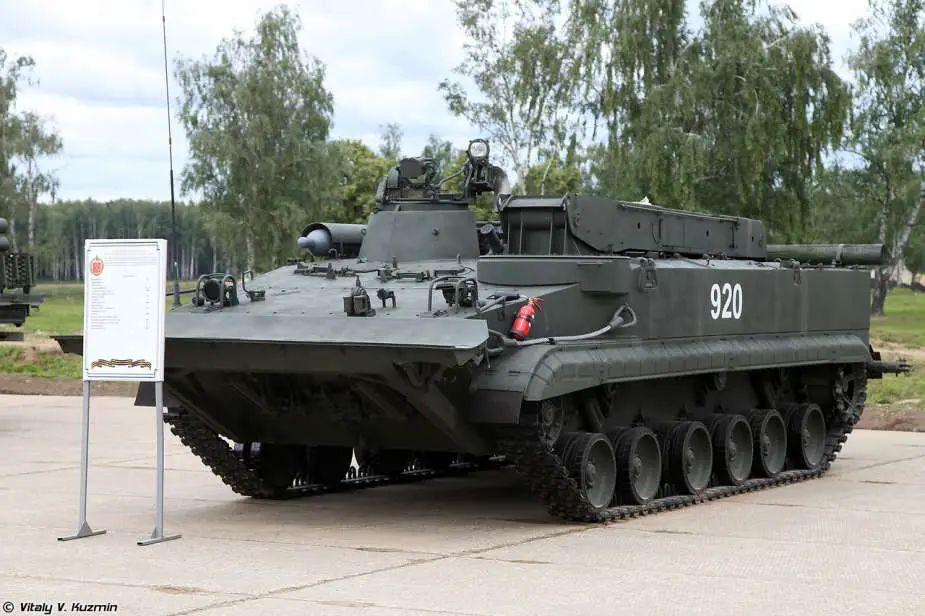- Army
- Conflicts in the world
- Israel - Iran conflict 2025
- Pakistan - India Conflict 2025
- Russia Ukraine War 2022
- Libya conflict day by day
- HAMAS - Israel War 2023
- Operation Serval in Mali French Army
- Sangaris operation Central African Republic
- Sangaris opération militaire République Centreafrique
- Ukraine - Russia conflict
- Syria conflict news
- Defence & Security Industry Technology
- Armies in the world
- Analysis Defense and Security Industry
- Conflicts in the world
- Navy
- Air
Ukrainian Forces Destroy First Russian BREM-L Recovery Vehicle with Drone-Dropped Munition
On August 3, 2023, a video shared by the "GloOouD" Twitter account revealed that Ukrainian forces successfully targeted and destroyed a Russian BREM-L, a tracked armored recovery vehicle based on the BMP-3 IFV chassis. This marks the first time such a vehicle has been taken down using drone-dropped munitions, a method frequently employed by Ukrainian troops against Russian positions and armored units
Follow Army Recognition on Google News at this link

Ukrainian soldiers destroy Russian BREM-L tracked armored recovery vehicle using drone-dropped munition. (Picture source Video Footage Twitter GloOouD)
In the evolving landscape of global conflicts, the emergence and rapid adoption of drone-dropped munitions offer a glimpse into the future of warfare. These weapons, released or fired from unmanned aerial vehicles (UAVs), are rapidly changing the dynamics on the battlefield.
Designed for precision, drone-dropped munitions enable forces to execute targeted strikes with heightened accuracy. This capability minimizes the risk of collateral damage and allows for the elimination of high-value targets without endangering troops on the ground or pilots in the air. Furthermore, drones can hover over targets for extended periods, providing real-time surveillance and intelligence that ensure the accuracy of strikes.
While the advanced capabilities of drones offer distinct strategic advantages, they also present a more cost-effective approach to warfare. The elimination of a pilot from the equation means missions deep in enemy territory, previously deemed too perilous for human involvement, can now be undertaken by drones. Their flexibility in deployment, with the ability to launch from platforms ranging from ships to trucks, underscores their increasing utility in modern military operations.
However, as with all significant technological leaps in the realm of combat, the rise of drone warfare is not without its challenges and criticisms.
Detractors of the technology argue that drone-based warfare makes combat too impersonal. They worry this could lower the threshold for using lethal force. Concerns also abound regarding the potential for civilian casualties, particularly when acting on flawed or outdated intelligence.
Additionally, the increasing accessibility of drone technology means that various state and non-state actors now possess drone capabilities. This proliferation has made global battle spaces more intricate, leading to increased efforts to develop countermeasures. From jamming equipment to interceptor drones and traditional anti-aircraft systems, the race is on to mitigate potential drone threats.
In conclusion, while drone-dropped munitions signify the cutting edge of military technology and strategy, they come with a set of challenges and ethical quandaries that the world must address. As the drones soar, so too do the stakes of modern warfare.
The BREM-L is a Russian-made tracked armored recovery vehicle used to provide technical support for armored units. It's based on the tracked chassis of the Russian BMP-3 infantry fighting vehicle, specifically modified to conduct repair and recovery operations on the battlefield.
The BREM-L is equipped with specialized equipment to carry out its role, such as a crane, winch, and dozer blade, among others. The purpose of such vehicles is to recover and repair damaged or immobilized armored vehicles under combat conditions. They are essential for maintaining the operational tempo and combat effectiveness of armored units.
The specifications, features, and exact capabilities of the BREM-L might vary, but generally, it's designed to tow disabled armored vehicles, perform minor repairs in the field, and assist in the extraction of vehicles that have been immobilized due to obstacles or terrain.

Russia-made BREM-L is a tracked armored recovery vehicle based on tracked chassis of the BMP-3 IFV Infantry Fighting Vehicle. (Picture source Vitaly Kuzmin)
News Russia Ukraine War


























